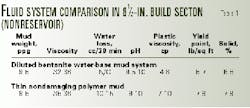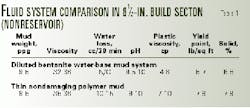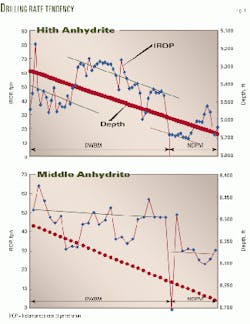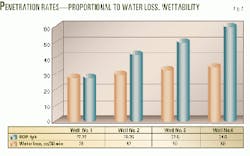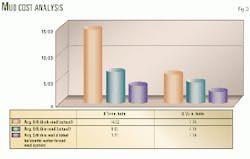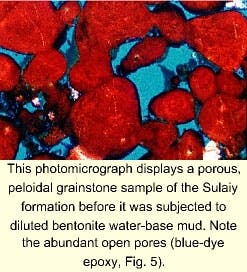Diluted bentonite efficiently drills nonreservoir section
QATARI DRILLING FLUIDS-Conclusion
Use of diluted bentonite water-base mud systems and a turbulent flow regime throughout the nonreservoir sections of Dukhan field, Qatar, has improved penetration rates and costs compared with non-damaging polymer mud systems.
Furthermore, no operational problems have been encountered during use of diluted bentonite water-base mud systems.
The rapid removal of cuttings allows each successive tooth impact to attack new rock, leading to increased penetration rates. For this purpose, high turbulent flow conditions at the hole bottom have become desirable.
Thus, it is important to understand those drilling fluid properties that affect penetration rate including filtration loss and surface tension.
Effects
Workers have explained the effect of filtration on drilling permeable rocks in conjunction with the effects of hydrostatic pressure.1 2 These authors found that penetration rates were not affected by imposed borehole pressures when equalized ahead of the bit.
Water, for example, may readily enter a permeable rock ahead of the bit so that no pressure differential exists across the thin element being drilled. Low water-loss mud, however, almost instantaneously deposits a tough, low-permeability filter cake on the hole bottom, producing a definite pressure differential.
This has two detrimental effects.
- The effective dynamic filtration pressure effect prohibits the bit tooth from penetrating the filter cake before contacting the rock.
- The loosened cuttings that are deposited and trapped in the pasty filter cake mixture will prevent mud flow ahead of the bit. Thus, the hydraulic action will be too slow to prevent a pressure reduction beneath the bit, requiring longer bottomhole clearance times.
The increased starch content in thick or thin nondamaging, low-shear, XC-Polymer mud systems used to reduce water loss could conceivably cause this behavior. Thus, the low fluid loss, which is desirable from the formation damage standpoint, is undesirable from the standpoint of drilling faster hole.
Wettability, on the other hand, acts as a rock hardness reducer. This suggests that microscopic cracks, which tend to heat themselves once the bit load has been released, may be held open by the wetting film of the liquid. This effect should facilitate chipping by the next tooth impact, reducing friction in between the bit tooth and rock.
Additionally, penetration rates in hard rock, using fresh water, have sometimes shown marked increases in the penetration rates. Therefore, it appears that alterations in wettability and surface tension play some part in rock drillability.
Furthermore, the effect of mud density is probably not completely expressed by the mud column. Rather, it should be considered in terms of the pressure differential between the interstitial fluid pressure in the rock and the imposed pressure of the borehole.
All rocks are porous, although some are so slightly porous that they are considered nonporous. In this case, internal pressures within the rock help remove the small drill cuttings below the bit, and thus increase drillability.
Rapid removal of cuttings below the bit allows for efficient turbulent flow condition at the hole bottom and is desirable for this purpose. Thus, an increase in the density of tooth impacts against the bottom of the hole leads to increased penetration rates and improved hole cleaning.
Bentonite WBM
As previously stated, the 121/4-in. vertical sections in all Qatar General Petroleum Corp. (QGPC) onshore horizontal wells are drilled with bentonite water-base mud. While the 81/4-in. deviated (nonreservoir rocks) and horizontal sections (reservoir rocks) are mainly drilled from kick-off point to TD using thin, nondamaging, low-shear polymer systems, both sections are isolated by a production string cemented off-bottom to provide a barefoot completion.
To improve penetration rates further and build tendencies across the hard formation streaks, while decreasing the cost of treatment and conditioning for the thin polymer mud, QGPC decided to drill the 81/2-in. build section by using bentonite WBM systems instead of thin nondamaging polymer mud system.
To do so, mud engineers modified the diluted bentonite water-base mud system used to drill the vertical sections, applying it in the deviated sections of more than 14 wells with a total footage of about 20,000 ft. It was also decided to continue drilling the horizontal sections using a nondamaging polymer mud system.
The modified diluted bentonite water-base mud system has similar mud rheologies to the nondamaging polymer mud system (Table 1).
Following are the findings:
1. The average instantaneous penetration rates improved 45.4%/well. Improvements in hole cleaning were also experienced (Fig. 1).
2. Penetration rates are found to be directly proportional to water loss variations and wettability alternations (Fig. 2). The water loss level was kept highly open by adding lime as a dispersing, low-velocity gel into the mud system (Wells 3 and 4).
3. Use of diluted bentonite water-base mud system in drilling deviated section and thin nondamaging polymer mud system in the reservoir horizontal section led to savings on mud treatment and conditioning that reduced mud costs by 47% in the 81/2 and 61/8-in. hole sections (Fig. 3).
4. Build-rate tendency (BUR) and steerability have been improved by 10% as hard streaks were drilled much faster. Accordingly, additional trips for deviation control were eliminated (Fig. 4). Also, the BUR is directly proportional to the rate of penetration.
5. The "no control" on water loss with diluted bentonite water-base mud system has shown no effect on formation washouts.
6. Downhill drag and fill during connections and trips were reduced or eliminated. Also, the formation of ledges at the top of new horizons disappeared. No washouts occurred across the deviated section.
Water loss and formation invasion
In order to investigate the effect of the diluted bentonite drilling mud on fluid loss and invasion in formation rocks such as Sulaiy, Hith, Arab A, Upper Anhydrite, Arab B and Arab C (reservoir rocks), investigators subjected representative core plugs to a series of dynamic fluid tests (Fig. 5), using a computerized Model 90 Dynamic Fluid loss system.
This instrument became very useful in determining the dynamic fluid loss and filter cake building of a given mud system even under extreme conditions with temperatures up to 250° F. and pressures up to 2,500 psi.
Results of the fluid loss test showed that the field mud exhibited very high spurt loss and high dynamic fluid loss in all of the tested plug samples. For the fluid-invasion test, investigators examined the core plugs petrographically before and after they were subjected to the thin non-damaging polymer mud system.
This examination revealed that tight samples such as anhydrite did not experience any mud invasion. However, the fairly porous samples experienced some invasion (more than 5%) of the porosity while the most porous samples (bioclastic peloidal grainstone) were represented by about 15% of the porosity (Fig. 6).
References
- Murray, A.S, and Cunnigham, R.A., "Effect of mud column pressure on drilling rates," AIME, v. 204, 1955, p. 196.
- Bourgoyene Jr., A.T., Millheim, K.K., Chenevert, M.E., and Young Jr., F.S., Applied drilling engineering, Society of Petroleum Engineering, 2nd edition, 1991.
